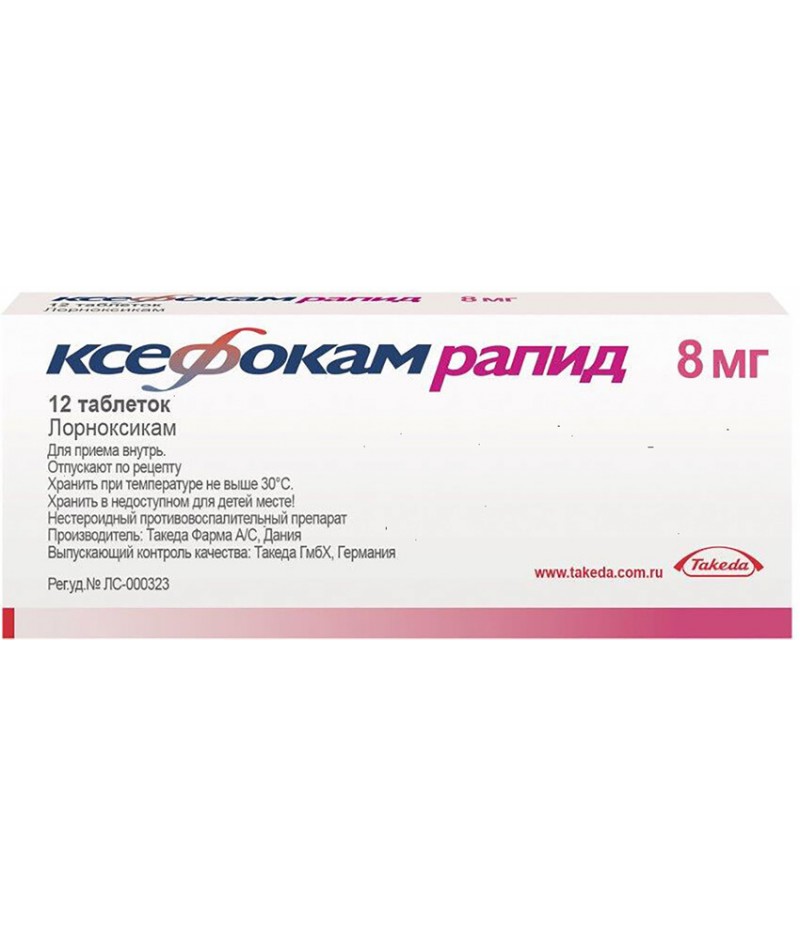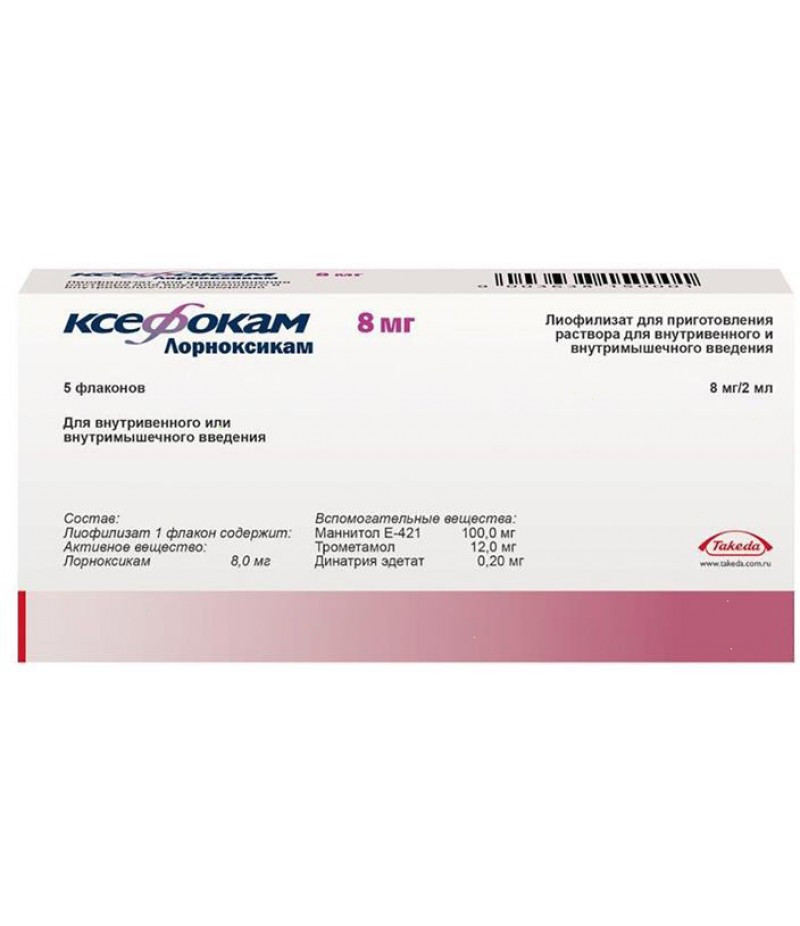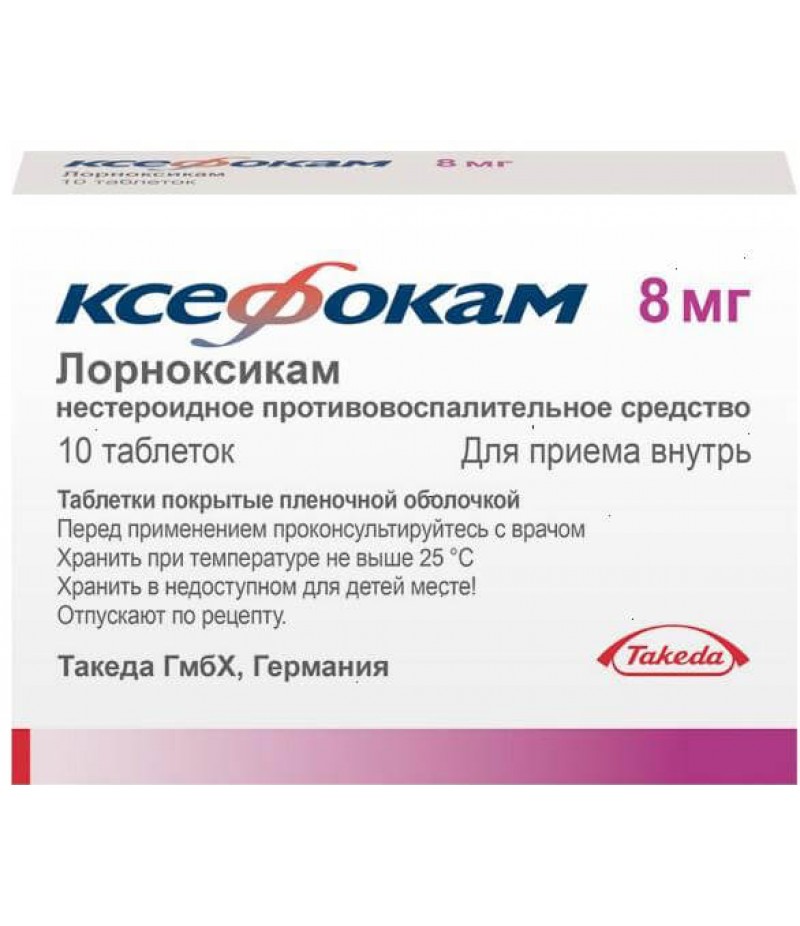Xefocam Rapid tabs 8mg #12
- $18.78
- 3 or more $18.50
- Availability:In Stock
Xefocam Rapid user manualReed more and buy Xefocam Rapid on this pageComposition1 tablet of the drug Xefocam Rapid contains 8 mg lornoxicam.Auxiliary components: calcium stearate, titanium dioxide, gi
Tags: tabs
Xefocam Rapid user manual
Reed more and buy Xefocam Rapid on this page
Composition
1 tablet of the drug Xefocam Rapid contains 8 mg lornoxicam.
Auxiliary components: calcium stearate, titanium dioxide, giprolase, sodium hydrogen carbonate, low-substituted giprolose, microcrystalline cellulose, calcium hydrogenphosphate, talc, propylene glycol, hypromellose.
Form of issue
White biconvex tablets of round shape.
6 pieces in a blister - 1 or 2 blisters in a pack of paper.
10 pieces in a blister - 10, 1, 2, 3, 5 or 25 blisters in a pack of paper.
pharmachologic effect
Anti-inflammatory and analgesic effect.
Pharmacodynamics and pharmacokinetics
Pharmacodynamics
Anti-inflammatory non-steroid drug. Has a pronounced analgesic and anti-inflammatory effect. Lornoxicam has a rather complex mechanism of action, which includes inhibition of prostaglandin synthesis, caused by inhibition of cyclooxygenase activity. The blocking of cyclooxygenase leads to the suppression of peripheral pain receptors and to the cessation of signs of inflammation. Lornoxicam also reduces the production of oxygen radicals by leukocytes that have undergone activation. The analgesic effect of the drug is not associated with an opiate-like effect on the nervous system and is not accompanied by respiratory depression or the emergence of drug dependence.
Does not affect important vital signs: respiratory rate, ECG parameters, body temperature, heart rate, blood pressure, spirometry.
Pharmacokinetics
After oral administration, lornoxicam is rapidly and completely adsorbed from the intestine. The greatest concentration in the blood occurs in an hour and a half. The intake of food reduces the maximum concentration by 30% and increases the half-life to 2.3 hours. Bioavailability of lornoxicam reaches 92-100%. Binding to blood proteins is 99% and does not depend on its content.
The active substance is completely transformed in the liver. The enzyme CYP2C9 participates in the transformation. In plasma, the drug is predominantly unchanged and, to a small extent, in the form of a hydroxylated metabolite, which does not possess pharmacological activity.
The elimination half-life is close to 4 hours. About a third of the metabolites are excreted in the urine and the remainder is excreted in the bile.
In elderly people, as well as in patients with impaired hepatic and renal function, no changes in the pharmacokinetics of the drug have been detected.
Indications for use
Short-term treatment of acute pain moderate, mild and moderately strong.
Contraindications
A combination (complete or incomplete) of polyposis of paranasal sinuses or nose, bronchial asthma and intolerance of non-steroidal anti-inflammatory drugs (including in anamnesis).
Thrombocytopenia.
Hemorrhagic diathesis or blood clotting disorders, including conditions after surgery, associated with a bleeding or insufficient hemostasis.
The period after aortocoronary bypass surgery.
Changes in mucous duodenal ulcers or gastric erosive-ulcerative nature, active bleeding of gastrointestinal localization, as well as cerebrovascular or other bleeding.
Previous bleeding from the digestive system associated with the use of non-steroidal anti-inflammatory drugs.
Recurrent gastric ulcer or recurring bleeding from the digestive system.
Exacerbation of inflammatory bowel diseases (Crohn's disease).
Decompensated heart failure.
Lack of liver function or liver disease in the active phase.
Severe renal failure, progressive kidney disease, hyperkalemia, dehydration or hypovolemia.
Pregnancy and lactation.
Age is less than 18 years.
Allergy to the components of the medication.
Care should be taken when prescribing at least one of the following conditions: damage to the organs of the digestive tract of an erosive and ulcerative nature and bleeding of said localization, renal failure of moderate severity, postoperative state, arterial hypertension, age over 65 years, coronary heart disease, cerebrovascular disease , chronic heart failure, dyslipidemia, peripheral arterial disease, diabetes, smoking, creatinine clearance up to 60 m l / min, the presence of Helicobacter pylori, the ulcerative lesions of the digestive system in the past, the long-term use of anti-inflammatory non-steroid drugs, severe somatic diseases, alcoholism, joint intake of oral forms of glucocorticosteroids, anticoagulants, antiplatelet agents, diuretics, selective serotonin uptake blockers or drugs with nephrotoxic action .
Joint therapy with anti-inflammatory non-steroid drugs and Tacrolimus can increase the risk of nephrotoxicity.
Simultaneous reception of anti-inflammatory non-steroid drugs and Heparin on the background of epidural or spinal anesthesia increases the likelihood of epidural and spinal hematomas.
Side effects
The most frequent adverse reactions to the use of anti-inflammatory non-steroid drugs are: the appearance of peptic ulcers, perforation of the hollow organ or bleeding of the gastrointestinal localization. Also noted are vomiting, nausea, diarrhea, constipation, flatulence, abdominal pain, dyspepsia, bloody vomiting, melena, exacerbation of colitis, ulcerative stomatitis, exacerbation of Crohn's disease, gastritis. Approximately 20% of patients taking lornoxicam can develop unwanted reactions.
Reactions from hematopoiesis: anemia, leukopenia, thrombocytopenia, increased duration of bleeding, ecchymosis.
Reactions from the immune system: allergies.
Reactions from the metabolism: anorexia, increase or decrease in weight.
Reactions from the psyche: depression, sleep disturbance, nervousness, confusion, anxiety.
Reactions from the nervous activity: temporary weak headaches, dizziness, paresthesia, somnolentia, tremor, taste disorder, migraine.
Reactions from vision: conjunctivitis, visual impairment.
Reactions from the side of the vestibular apparatus: tinnitus, dizziness.
Reactions from the circulation: tachycardia, palpitation, heart failure, edema, hot flashes, hemorrhages, arterial hypertension, hematoma.
Response from the respiratory organs: rhinitis, dyspnoea, pharyngitis, bronchospasm, cough.
Digestive reactions: abdominal pain, nausea, dyspepsia, vomiting, diarrhea, flatulence, constipation, dry mouth, belching, peptic ulcer, gastritis, ulceration in the oral mucosa, bloody vomiting, glossitis, melena, stomatitis, gastroesophageal reflux, esophagitis, aphthous stomatitis, dysphagia, perforated ulcer.
Reactions from the hepatobiliary system: increased concentrations of glutamate-pyruvate-transaminase and glutamate-oxaloacetate transaminase, damage to hepatocytes, impaired liver function.
Reactions from the skin: itching, rash, sweating, urticaria, dermatitis, alopecia, purpura, bullous reactions, edema, epidermal toxic necrolysis, Stevens-Johnson syndrome.
Reactions from the musculoskeletal system: arthralgia, muscle spasms, bone pain, myalgia.
Reactions from the urinary system: impaired urination, nocturia, an increase in the concentration of urea or creatinine in the blood.
General reactions: swelling of the face, malaise, asthenia.
Instructions for use Xefocam Rapid (Method and dosage)
Instruction on Xefocam Rapid indicates that this drug is intended only for oral administration and should be consumed by drinking 100 ml of liquid. For elderly patients, there is no need for a special dose selection in the absence of kidney or liver diseases, in which case the dosage should be reduced. For all groups of patients, the regimen for taking and selecting doses should be based on an individual response to treatment.
On the first day of treatment it is allowed to take 16 mg as the initial dose and 8 mg of the remedy after another 12 hours. In the following, the maximum daily dosage should not be more than 16 mg. The standard dose is 8-16 mg per day.
To reduce the likelihood of adverse events, the minimum effective dose size should be given by the least short course.
Overdose
In case of an overdose, the following symptoms are possible: dizziness, nausea and vomiting, ataxia, visual disturbances, convulsions, coma. Changes in the liver and kidneys, as well as blood clotting disorders, are not excluded.
Treatment of an overdose: discontinue the introduction or taking of a medicine.
Lornoxicam is rapidly evacuated from the body. The use of dialysis is ineffective, the selective antidote is not known. It is necessary to carry out urgent measures, including reception of enterosorbents and gastric lavage. To treat digestive disorders, Ranitidine or prostaglandin analogs are allowed.
Interaction
When combined with cimetidine, the concentration of lornoxicam in the blood increases.
When used simultaneously with anticoagulants or blockers of platelet aggregation, an increase in the duration of bleeding and an increase in the probability of bleeding may be excluded.
Joint use with Fentprokumon reduces its therapeutic effectiveness.
When taking anti-inflammatory non-steroid drugs with Heparin during spinal or epidural anesthesia, the risk of spinal and epidural hematomas increases.
When combined with ACE inhibitors and beta-adrenoblockers, their hypotensive effect decreases.
The drug weakens the hypotensive and diuretic effect of diuretics, and also lowers the clearance of digoxin.
At simultaneous application with antibiotics of group of quinolones the risk of development of a convulsive syndrome increases.
When combined with other anti-inflammatory non-steroidal drugs or glucocorticosteroids, the risk of bleeding from the digestive system increases.
The drug raises the content of Methotrexate in the blood when they are used together.
When used simultaneously with selective blockers, seizure of serotonin increases the risk of bleeding from the digestive system.
Xefocam Rapid is able to cause an increase in the concentration of lithium in the blood, enhancing the side effects of the latter when they are taken together.
Xefocam Rapid stimulates the nephrotoxic effects of Cyclosporine and the hypoglycemic effect of sulfonylurea preparations.
When combined with potassium, corticotropin, alcohol, the risk of undesirable effects on the part of digestion increases.
When used concomitantly with cefotetan, cefoperazone, cefamandol, valproic acid increases the likelihood of bleeding.
With a joint admission with Tacrolimus, the threat of nephrotoxicity increases.
Storage conditions
Store at room temperature. Keep away from children.
Shelf life - Two years.
special instructions
The likelihood of ulcerogenic action of the drug can be reduced by simultaneous administration of proton pump inhibitors and artificial prostaglandin analogues. When bleeding occurs from the digestive organs, the medication should be stopped immediately and emergency measures taken. It is especially necessary to observe patients with pathology of the gastrointestinal tract, who first take the drug.
Like any other oxicam, the described drug inhibits platelet aggregation, which causes an increase in the duration of bleeding. When using the drug, you need to closely monitor the condition of patients who need the normal physiological functioning of the blood clotting system (for example, those who are scheduled to undergo surgery) who have blood coagulation disorders or who take anti-clotting drugs in order to identify signs of bleeding in time .
If signs of liver damage are found (jaundice of the skin, itchy skin, vomiting, nausea, darkening of the urine, abdominal pain, increased liver transaminases), stop taking the medication immediately and consult a doctor.
It is forbidden to apply the drug at the same time as other anti-inflammatory non-steroid drugs.
Xefocam Rapid is able to change the properties of platelets, but it does not replace the preventive effect of Aspirin in cardiovascular disorders.
Patients with impaired renal function, triggered by severe blood loss or dehydration, the drug, as an inhibitor of prostaglandin biosynthesis, is allowed to be prescribed only after relief of hypovolemia and the resulting risk of reducing renal perfusion.
The described drug can cause an increase in urea and creatinine in the blood, as well as sodium, water, arterial hypertension, peripheral edema and some other early symptoms of nephropathy.
Long-term therapy of such patients with Xefocam Rapid can cause glomerulonephritis, nephrotic syndrome and even acute kidney failure.
In the elderly, as well as those suffering from arterial hypertension or obesity, it is necessary to monitor blood pressure.
It is especially important to observe the function of the kidneys in elderly patients, as well as in people taking diuretics or drugs potentially damaging the kidneys.
With long-term use of the drug, hematologic parameters, as well as renal and liver parameters, should be regularly monitored.
Persons receiving the drug are strongly advised to refrain from driving and drinking alcohol.
Children
The drug is not assigned to patients under 18 years of age.
With alcohol
Joint intake of alcohol and the drug Xefocam Rapid can enhance the toxic effects of the drug. Avoid the use of alcohol-containing beverages during the period of drug therapy.
In pregnancy and lactation
It is forbidden to take the drug during the periods indicated.
Reviews about Xefocam Rapid
Reviews of the drug indicate its good ability to cope with pains of mild and moderate strength, but the drug because of high toxicity can not be used for systematic admission.
The difference between Xefocam Rapid and Xefocam
The drugs are complete analogs, the doses produced and the prices are the same. The difference is that Xefocam has an additional release form for injection (lyophilizate).



